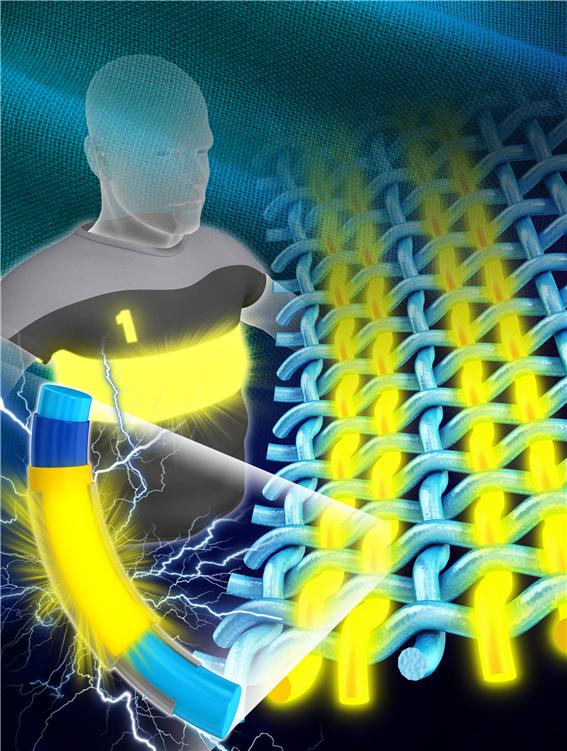KAIST Develops Fiber-Like Light Emitting Diodes for Wearable Displays

The Next Generation Wearable Display Using Fiber Based Light Emitting Diodes. Copyright: KAIST
Professor Kyung-Cheol Choi and his research team from the School of Electrical Engineering at KAIST have developed fiber-like light emitting diodes, which can be applied in wearable displays. The research findings were published online in the July 14th issue of Advanced Electronic Materials.
Traditional wearable displays were manufactured on a hard substrate, which is later attached to the surface of clothes. Such technique has posed limitations in applying it for wearable displays because inflexible displays were not adequate in practice, and the characteristics of fabric were ignored.
For a solution, the research team discarded the tradition of creating light emitting displays on a plane board. Instead, they focused on fibers, a component of fabrics, and developed a fiber-like light emitting diode that has the characteristics of both fabrics and displays.
The essence of this technology, the dip coating process, is to immerse and extract a three dimensional (3-D) board that looks like a thread in a solution. Then, the regular levels of organic materials are formed as films on the board.
The dip coating process allowed the layers of organic materials to be easily created on boards with a 3-D structure including a cylinder, which had been difficult in existing processes such as heat coating process. The coating thickness can also be adjustable to hundreds of thousands of nanometers through the control of withdrawal rate.
The researchers said that this technology would accelerate the commercialization of fiber based wearable displays since it offers low-cost, mass production using roll-to-roll processing, a technology applied to create electronic devices on a roll of flexible plastics or metal foils.
Professor Choi said, “Our research will become a core technology in developing light emitting diodes on fibers, which are fundamental elements of fabrics. Hopefully, we can lower the barrier of wearable displays to enter the market.”
The first author of the published paper, Seon-Il Kwon, added, “This technology will eventually allow the production of wearable displays to be as easily as making clothes.”
Associated links
Original press release from KAIST
Media Contact
More Information:
http://www.researchsea.comAll latest news from the category: Materials Sciences
Materials management deals with the research, development, manufacturing and processing of raw and industrial materials. Key aspects here are biological and medical issues, which play an increasingly important role in this field.
innovations-report offers in-depth articles related to the development and application of materials and the structure and properties of new materials.
Newest articles

NASA: Mystery of life’s handedness deepens
The mystery of why life uses molecules with specific orientations has deepened with a NASA-funded discovery that RNA — a key molecule thought to have potentially held the instructions for…

What are the effects of historic lithium mining on water quality?
Study reveals low levels of common contaminants but high levels of other elements in waters associated with an abandoned lithium mine. Lithium ore and mining waste from a historic lithium…

Quantum-inspired design boosts efficiency of heat-to-electricity conversion
Rice engineers take unconventional route to improving thermophotovoltaic systems. Researchers at Rice University have found a new way to improve a key element of thermophotovoltaic (TPV) systems, which convert heat…



